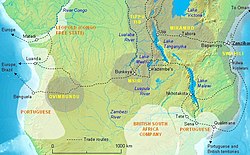Yeke Kingdom
Yeke Kingdom | |||||||
|---|---|---|---|---|---|---|---|
| 1856–1891 | |||||||
 South-central Africa in 1880 showing the central position of Msiri’s Kingdom and the principaltrade routes,with the approximate territories of Msiri’s main allies (names in yellow) and the European powers (names in orange) before borders were settled by theBerlin Conference.The east coast trade was controlled by theSultan of Zanzibar.Areas of influence of other tribes and of France and Germany not shown | |||||||
| Capital | Bunkeya | ||||||
| Government | Monarchy | ||||||
• 1856–1891 | Msiri | ||||||
| Historical era | Scramble for Africa | ||||||
•Msiri's rise to power | 1856 | ||||||
•Msiri's death | 20 December 1891 | ||||||
| |||||||
TheYeke Kingdom(also called theGaranganzeorGarenganzekingdom) of theGaranganze peopleinKatanga,DR Congo,was short-lived, existing from about 1856 to 1891 under one king,Msiri,but it became for a while the most powerful state in south-central Africa, controlling a territory of about half a million square kilometres. The Yeke Kingdom also controlled the onlytrade routeacross the continent from east to west, since theKalahari DesertandLozi Kingdomin the south and theCongo rainforestin the north blocked alternative routes. It achieved this control through natural resources and force of arms—Msiri traded Katanga'scopperprincipally, but alsoslavesandivory,forgunpowderand firearms—and by alliances through marriage. The most important alliances were withPortuguese–Angolansin theBenguelaarea, withTippu Tipin the north and withNyamweziandSwahilitraders in the east, and indirectly with theSultan of Zanzibarwho controlled the east coast traders.[1]
Msiri was in fact aNyamwezi(also known as 'Yeke' or 'Bayeke') fromTaborainTanzaniawho got himself appointed as successor to a Wasanga chief west of theLuapula Riverby defeating the chief'sLundaenemies. Once installed he conquered the neighbouring tribes and expanded the chieftainship into a kingdom.
From its capital atBunkeya,the Yeke Kingdom took over the western territory ofMwata Kazembe,stopped the southwards expansion of theLuba Empireand subjugated tribes in the southwest, on the trading route toAngola.
When KingLeopold II of Belgiumwas told that the Yeke Kingdom controlled east-west trade and was rich incopperand possiblygold,he sent expeditions to try to obtain a treaty for the kingdom to join hisCongo Free State(CFS).Cecil Rhodesalso sent expeditions to sign up the kingdom to hisBritish South Africa Company's chartered territories. The 'scramble for Katanga' was won by Leopold'sStairs Expedition,which ended the kingdom by killing Msiri, and took over the territory for the CFS, but with its own administration until it was more closely incorporated into theBelgian Congo.[1]
Captain Stairs,the expedition's leader, installed one of Msiri's adopted sons, Mukanda-Bantu, as his successor but of a vastly reduced area with a radius of only 20 km from Bunkeya, and with the status of a chief.[1]The chieftainship continues to this day under the titleMwata Msiri.[2]
See also[edit]
References[edit]
- ^abcJoseph A. Moloney: With Captain Stairs to Katanga. S. Low, Marston & Company, London, 1893.
- ^http:// kingmsiri /index2.htm"Mwami Msiri, King of Garanganze". Website accessed 8 February 2007.
